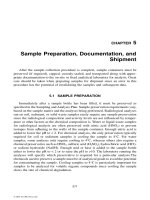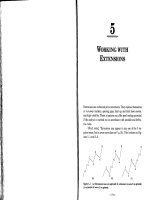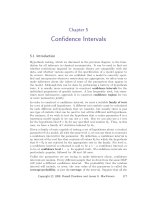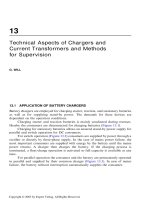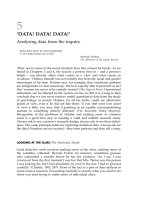Personality classic theories and modern research 6th chapter 5 biological aspects of personality
Bạn đang xem bản rút gọn của tài liệu. Xem và tải ngay bản đầy đủ của tài liệu tại đây (257.54 KB, 38 trang )
Personality
Sixth edition
Chapter 5
Biological Aspects of
Personality
Copyright © 2016, 2012, 2009 Pearson Education, Inc. All Rights Reserved
Modules (1 of 2)
Introduction: Biological Aspects of Personality
5.1: Direct Genetic Effects
5.2: Genetic Effects through Temperament
5.3: Twins as a Source of Data
5.4: Sexual Identity and Sexual Orientation
5.5: Mediated Effects of Biology
5.6: Effects from Creation of Environments
Copyright © 2016, 2012, 2009 Pearson Education, Inc. All Rights Reserved
Modules (2 of 2)
5.7: Effects from Reactions of Others
5.8: Sociobiology
5.9: Darwinism and Social Darwinism
Conclusion: Biological Aspects of Personality
Copyright © 2016, 2012, 2009 Pearson Education, Inc. All Rights Reserved
Learning Objectives (1 of 2)
5.1: Recognize Charles Darwin's theory of evolution
5.2: Examine the four basic aspects of temperament
5.3: Analyze the study of twins as a method to
discover the genetic influences on personality
5.4: Report various aspects of identity and sexuality
5.5: Examine the effects of different diseases to
understand psychology
Copyright © 2016, 2012, 2009 Pearson Education, Inc. All Rights Reserved
Learning Objectives (2 of 2)
5.6: Scrutinize how the environment affects our
personality
5.7: Scrutinize the physical attractiveness
stereotype
5.8: Examine the theory of sociobiology
5.9: Analyze Darwin's 'survival of the fittest" theory
and decipher its true meaning
Copyright © 2016, 2012, 2009 Pearson Education, Inc. All Rights Reserved
Introduction: Biological Aspects of
Personality
− Self-fulfillment through proper rearing and hard
work
− Biological responses
− Effects of biology on personality
− Effects of heredity on personality
Copyright © 2016, 2012, 2009 Pearson Education, Inc. All Rights Reserved
5.1: Direct Genetic Effects
Objective: Recognize Charles Darwin's theory of evolution
− Charles Darwin
− Anatomical relations between humans and
primates
Copyright © 2016, 2012, 2009 Pearson Education, Inc. All Rights Reserved
5.1.1: Natural Selection and Functionalism
− Natural selection
− Examples of functionalism
− Evolutionary personality theory
Copyright © 2016, 2012, 2009 Pearson Education, Inc. All Rights Reserved
5.1.2: Angelman Syndrome
− Overview
− Afflictions
Copyright © 2016, 2012, 2009 Pearson Education, Inc. All Rights Reserved
5.1.3: Behavioral Genomics
− Human genome
− Behavioral genomics
Copyright © 2016, 2012, 2009 Pearson Education, Inc. All Rights Reserved
5.2: Genetic Effects through
Temperament
Objective: Examine the four basic aspects of temperament
− Pavlov’s research
− Temperament
Copyright © 2016, 2012, 2009 Pearson Education, Inc. All Rights Reserved
5.2.1: Activity, Emotionality, Sociability,
Impulsivity
− Aspects of temperament
− Measuring children’s temperament dimensions
Copyright © 2016, 2012, 2009 Pearson Education, Inc. All Rights Reserved
5.2.2: Eysenck’s Model of Nervous System
Temperament
− Methods to explain basic temperaments
− Eysenck’s work on introversion-extroversion
Copyright © 2016, 2012, 2009 Pearson Education, Inc. All Rights Reserved
5.2.3: Gray’s Reinforcement Sensitivity
Theory
− Overview
− Relevant biological systems
Copyright © 2016, 2012, 2009 Pearson Education, Inc. All Rights Reserved
5.2.4: Sensation Seeking and AddictionProneness
− Sensation-seekers
− Cocaine
Copyright © 2016, 2012, 2009 Pearson Education, Inc. All Rights Reserved
5.3: Twins as a Source of Data
Objective: Analyze the study of twins as a method to discover the genetic influences on
personality
− Twin research
− Key dimensions
Copyright © 2016, 2012, 2009 Pearson Education, Inc. All Rights Reserved
5.3.1: Sir Francis Galton
− Overview
− Flaw in belief
Copyright © 2016, 2012, 2009 Pearson Education, Inc. All Rights Reserved
5.3.2: Minnesota Twin Study
− Jack and Oskar
− Conclusions
Copyright © 2016, 2012, 2009 Pearson Education, Inc. All Rights Reserved
5.3.3: Nurture and Nonshared
Environmental Variance
− The Nurture Assumption
− Nonshared environmental variance
Copyright © 2016, 2012, 2009 Pearson Education, Inc. All Rights Reserved
5.3.4: Epigenetics
− Overview
− Aspects affecting personality
Copyright © 2016, 2012, 2009 Pearson Education, Inc. All Rights Reserved
5.3.5: Schizophrenia, Bipolar Disorder,
Depression
− Schizophrenia
− Bipolar disorder
− Depression
Copyright © 2016, 2012, 2009 Pearson Education, Inc. All Rights Reserved
5.4: Sexual Identity and Sexual
Orientation
Objective: Report various aspects of identity and sexuality
− Freud’s analysis
− Differences between heterosexuals and
homosexuals
Copyright © 2016, 2012, 2009 Pearson Education, Inc. All Rights Reserved
5.4.1: Reproductive Advantage
− Kin selection
− Inclusive fitness
Copyright © 2016, 2012, 2009 Pearson Education, Inc. All Rights Reserved
5.4.2: Hormones and Experience
− Early hormonal experiences
− Factors affecting C.N.S.
Copyright © 2016, 2012, 2009 Pearson Education, Inc. All Rights Reserved
5.5: Mediated Effects of Biology
Objective: Examine the effects of different diseases to understand psychology
− Vincent van Gogh
− Ménière’s disease
Copyright © 2016, 2012, 2009 Pearson Education, Inc. All Rights Reserved




